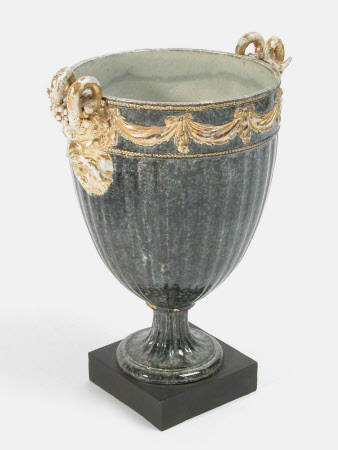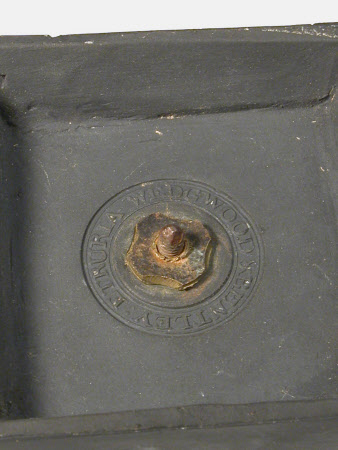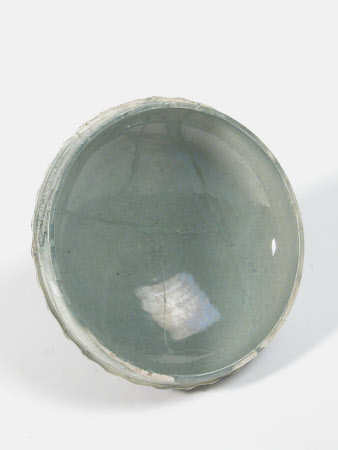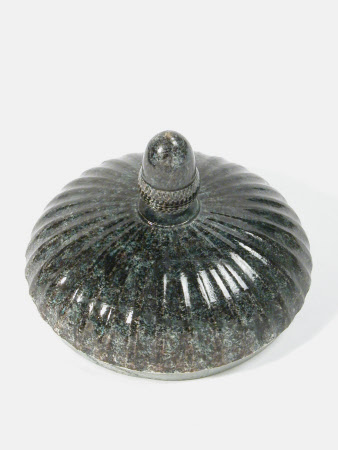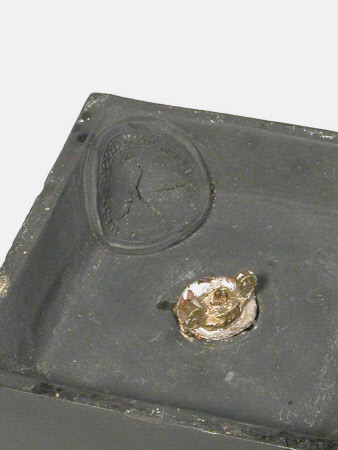Vase and cover
Wedgwood & Bentley
Category
Ceramics
Date
1772 - 1775
Materials
Basaltware
Measurements
180 mm (Height); 110 mm (Diameter); 105 mm (Diameter)
Place of origin
Etruria
Order this imageCollection
Saltram, Devon
NT 870801
Summary
Two vases and covers, a variant of Wedgwood's 'Shape no. 26', white stoneware (‘terracotta’), black basalt, ovoid body on low pedestal foot, standing on a square plinth, two handles in the form horned masks, domed cover with large acorn knop, Wedgwood and Bentley, Etruria, Staffordshire, 1772-5; engine turned fluting to the cover and body, an applied band of swags beneath the rim, the body and cover decorated in imitation of natural stone with cobalt blue, manganese and iron oxides under the glaze, traces of cold gilding to the swags and handles.
Full description
In 1769, Josiah Wedgwood announced his intention to become ‘Vase Maker General to the Universe’, capitalising on the vase mania that followed the widely publicised excavations of Pompeii and Herculaneum. By 1772, he had over 100 vase shapes in production, available in three different ceramic bodies – creamware, ‘terracotta’ (stoneware) and black basalt – in various sizes, in an assortment of glazes, with plain or gilt details, and supported on black or white plinths. Inspiration was found in Attic red-figure pottery, ancient marble cinerary urns and colourful seventeenth-century hardstone vases of agate, jasper and porphyry, as well as French and Italian engravings. At Saltram, home of the Parker family, there is a Wedgwood and Bentley garniture for a chimneypiece, resembling fine-grained, dark grey granite. To simulate the depth of colour of the natural stone, the unglazed body was sprinkled before firing with powdered metallic oxides, a mixture of cobalt, iron and manganese, which was protected by a colourless lead glaze. Wedgwood termed the technique ‘variegated’ ware and marketed them as ‘Pebble Vases’. The honey gilding applied to the relief details imitates fashionable gilt-metal mounts on hardstone vases in the French neoclassical style known as goût grec. The tallest vase is a variant of Shape ‘no. 1’ in Wedgwood’s Vase Shape Drawing book (the factory’s record of their ornamental shapes in order of production), which is after an engraving by Joseph Marie Vien published in 1760. The pendant pair of ovoid vases with engine-turned flutes, Shape no. 26, was perhaps inspired by an etching by the German artist Friedrich Kirschner (1748–89), copied in English silver in about 1772–3. The form is similar to a mounted Sèvres vase of about 1765 at The Vyne. The vases are described in Wedgwood and Bentley’s 1774 catalogue: ‘Ornamental Vases of Antique Forms. They are generally sold in Pairs, or Sets of three, five or seven Pieces.’ Those at Saltram may have been part of a five-piece garniture that included two ensuite vase-shaped three-light oil lamps, only one of which survives. This lamp, on dolphin supports, was introduced by Wedgwood around 1770 and has the distinctive rope-like festoons of the goût grec. Five-piece sets, with lighting elements, were offered by Christie and Ansell in the auction of the manufactory’s new stock held on 3 December 1781: ‘lot 19 A set of five Granite; the two end Vases serving for Candelabra’. The Hon. Theresa Parker (1745–75), may have purchased the garniture under the influence of her brother, the newly posted ambassador to Spain, Thomas Robinson, 2nd Baron Grantham (1738–86), who corresponded almost weekly with her on matters of taste. In December 1771, Wedgwood’s London agent, conscious of Lord Grantham’s international influence, sent him news of their new ‘Pebble, Black Terra Cotta and painted Etruscan Vases’.6 However, in 1775, her brother-in-law, Montagu Edmund Parker (1737–1813), also bought ‘urns’ from Wedgwood and Bentley in London, perhaps including this garniture. Their collections were united through a marriage in 1842. Since the 1920s, the three vases have been displayed on Robert Adam’s chimneypiece in the Dining Room, formerly the library.
Makers and roles
Wedgwood & Bentley, potter
References
Ferguson 2016: Patricia F. Ferguson, Ceramics: 400 Years of British Collecting in 100 Masterpieces, Philip Wilson Publishers, 2016, pp. 135-7
